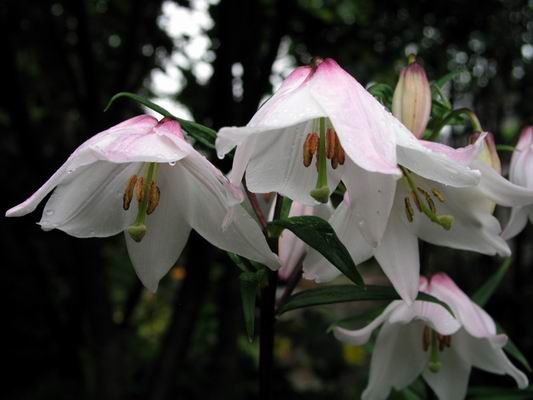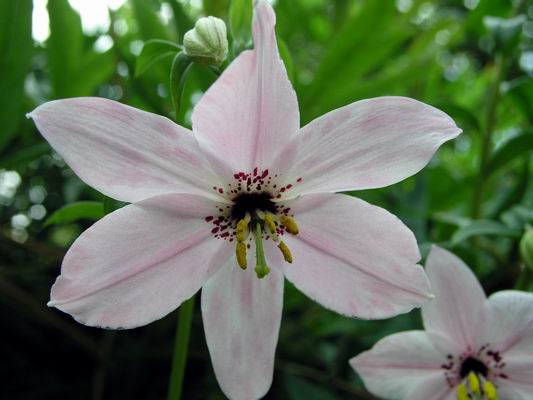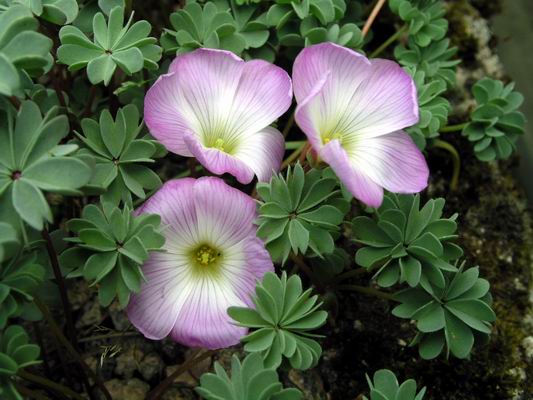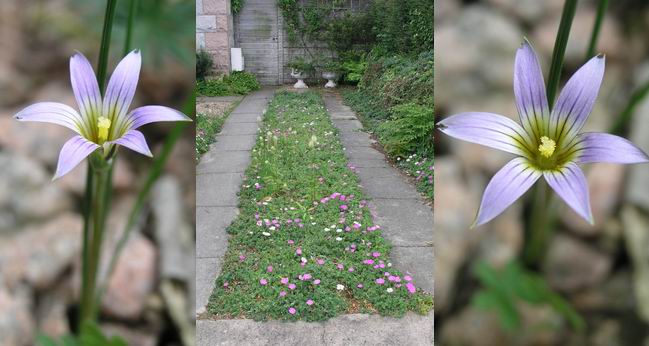 |
SRGC Bulb Log Diary |
| Home Recommend This Site To A Friend |
|
BULB LOG 24 -- 8th June 2004  Arum italicum 'Marmoratum'. Now that we are heading for Summer the Arums are producing their distinctive flowers. Arum italicum 'Marmoratum' is flowering well this year, perhaps it enjoyed the warm dry Summer of 2003 - the fruit in the Autumn will be more spectacular.  Arum dioscoridis. The flowers of Arum dioscoridis are a very spectacular combination of colours. A few years ago and unknown to Maggi, I planted a few of these in a narrow bed below our South facing kitchen window. One day I came into the kitchen to find her furiously cleaning the fridge for the second time - 'there is a terrible smell in the kitchen' she proclaimed, frustrated at not being able to locate it. I had to admit it was the flowers of Arum dioscoridis, which have a smell of pig slurry, wafting in through the open window.  Narcissus perez-chiscano seed The last of the Narcissus seed is now ripening and needs to be harvested. It is interesting to compare this seed from Narcissus perez-chiscano which is all black, to the seed of N. cyclamineus, pictured in last weeks log, which has white appendages. Now for the quiz - the weevil and the aphid are enlargements from the picture can you find them? It is amazing how often I find creatures in seed pods which is another good reason to collect your seed regularly as they are in there to feast on the seed.  Crocus seed pods Crocus seed pods continue to appear and it is best to pluck them before they ripen and shed their seed. Place your hand on the ground with the stem between your fingers and apply a sharp upward tug to remove the seed pod and stem. These can be left in a paper bag to open naturally or you can open them and pop out the clean seed like shelling peas.  Cleaning seed. When faced with a crumpling seed capsule mixed with seed, like this Ipheion, I place it on a sheet of card which is on a slight downward slope leading to a container. By gently tapping the board with your fingers the seed, being roundish, rolls down to the container leaving the detritus on the board. Any chaff that falls into the container can usually be removed by gently blowing until you see the chaff fly away and you are left with clean seed.  Lilium mackliniae 1. One of the most majestic of the lilies is Lilium mackliniae and it is just coming into flower now. It is easy to grow from seed and should be tried in every garden.  Lilium mackliniae 2. The flowers will vary in the amount of pink at the base of the petals but every one we have raised is just exquisite.  Nomocharis group. I make no excuses for showing another group of Nomocharis seedlings growing under the Rhododendrons.  Nomocharis petals. I am showing this close up picture to show the patchy pink colouring of the petals. This is often a sign that the plant is suffering from a virus.  Nomocharis with virus. The symptons of a virus infection can be seen more clearly in this picture. Notice the mottled colouration of both the petals and the leaves - as the infection becomes more advanced the leaves and petals will become distorted. Unfortunately Nomocharis are very susceptible to virus attack and it is difficult to prevent in a suburban garden. Many commonly grown and popular plants carry virus but have a strong enough system to still grow well, unfortunately Nomocharis cannot and infected plants will dwindle and die within a few years. I will harvest the seed from this infected plant and then destroy the bulb - virus does not appear to pass through the seed.  Oxalis adenophylla. When the sun shines the lovely soft flowers of Oxalis adenophylla sit on top of the fresh green leaves - this is one of a group we grew from seed collected in South America.  Romulea in drive. A tiny Romulea opens its flower for a day in our drive. It used be bare gravel until one year, while on my hands and knees weeding, it suddenly struck me that this was a scree bed. After thinking that we had run out of planting space in our garden I had found a long bed ideal for alpines and bulbs. Because the gravel was deep and hard packed we have planted everything by dropping in seed. It is full of Geranium sanguiniuim and lots of bulbs are now starting to flower from the seeds we have sown over the years. Crocus, frits, narcissus, erythronium, cyclamen, tulips are among those that have flowered so far. If you think you have run out of planting spaces in your garden go out and have another look. ^ back to the top ^ |